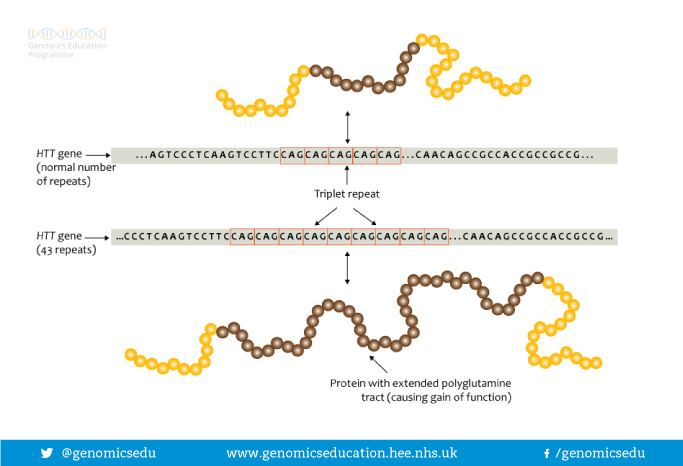The information that allows the normal development and functioning of each human being is coded in DNA, which exists in all cells of the body. Several successive segments of DNA make up a gene, with the human body containing approximately 20,000. Every gene has a different arrangement of DNA segments and itself codes for a protein with a specific function. Genes code for proteins in the sequence of their DNA: combination of DNA sequences “code” for different protein precursors called amino acids. Thus, information from DNA (“genes”) codes for amino acids, which come together to form proteins, who function to maintain the normal well-being of the body.
A small number of genes have a small segment of DNA that is repeated successively, usually a couple dozen times, for unknown reasons. When the respective protein is formed, it also possesses a repetition of the same amino acid, corresponding to the repeated DNA segment. These repetitions in proteins have the prefix “poly”, meaning that the amino acids are repeated multiple times in a row, causing an “expansion” in the protein. One of the most common repeated amino acids is called glutamine: hence the name, polyglutamine.

When there is an increase in the number of repetitions of these segments in DNA, we say that an expansion of the polyglutamine has occurred. When the number of glutamines is increased sufficiently, a disease can develop: we call these disorders “polyglutamine diseases”. Some examples of diseases caused by this polyglutamine expansion are Huntington’s disease, SCA1, SCA2, SCA3, SCA6, and SCA7. The difference between all these diseases is that the expansion of the DNA segment that causes the polyglutamine occurs in different genes. Since these genes are distinct, the way that this expansion interferes with the normal body functioning is also different, giving rise to altered clinical presentations and courses. Moreover, it has been well established that, the larger the number of times that the segment is repeated, the more severe the disease will be. Finally, it has also been observed that throughout each generation, abnormally increased segments tend to become even bigger, making the disease worse.
The discovery of this mechanism of disease has been very important for scientists, since it allows for a “molecular diagnosis” of the disease. Armed with this understanding, research is now focused on understanding this process and finding ways to block the negative effects of polyglutamine expansion.
If you would like to learn more about polyglutamine expansion, take a look at this article.
Snapshot written by Jorge Diogo Da Silva, edited by Dr. Maxime Rousseaux









